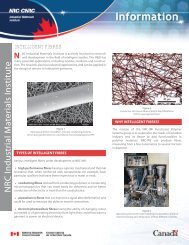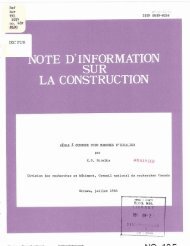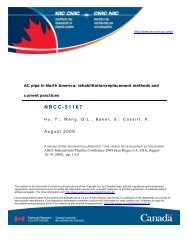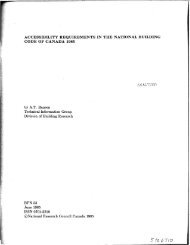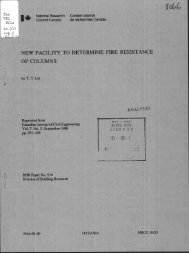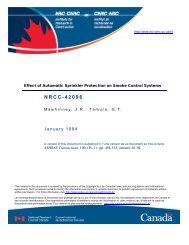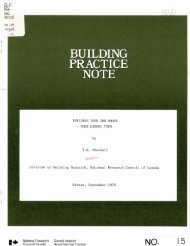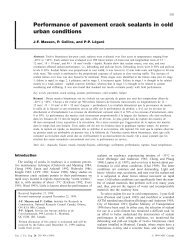Traffic-induced building vibrations in Montréal - National Research ...
Traffic-induced building vibrations in Montréal - National Research ...
Traffic-induced building vibrations in Montréal - National Research ...
Create successful ePaper yourself
Turn your PDF publications into a flip-book with our unique Google optimized e-Paper software.
Hunaidi and Tremblay 749Fig. 9. Vertical response and coherence functions obta<strong>in</strong>ed with thedrop weight device <strong>in</strong> summer and spr<strong>in</strong>g for the ground <strong>in</strong> front of<strong>build<strong>in</strong>g</strong> at site 9.measurements <strong>in</strong> summer and fall. Site response functions obta<strong>in</strong>edwith the drop weight device were used as an additionalsource of <strong>in</strong>formation on the effect of the frost layer and variation<strong>in</strong> ground water table level.Frozen soil samples were obta<strong>in</strong>ed at a depth of about 0.6to 0.8 m <strong>in</strong> front of the <strong>build<strong>in</strong>g</strong> at the time of w<strong>in</strong>ter tests.Dynamic shear moduli and damp<strong>in</strong>g ratios of the soil sampleswhile frozen and after they were allowed to thaw were determ<strong>in</strong>edfrom resonant column tests (Al-Hunaidi et al. 1996b).Fall versus w<strong>in</strong>ter vibration levelsVibration levels and ratios obta<strong>in</strong>ed dur<strong>in</strong>g the fall and w<strong>in</strong>terare listed <strong>in</strong> Tables 7 and 8, respectively. Vibration levelsmeasured <strong>in</strong> w<strong>in</strong>ter were about one half those measured <strong>in</strong> thefall. This is <strong>in</strong> agreement with the results reported by Sutherland(1950) for similar vibration measurements <strong>in</strong> W<strong>in</strong>nipeg.Ratios of <strong>vibrations</strong> measured by Sutherland (1950) were generallyhigher than those found <strong>in</strong> this study. This is believed tobe due to the depth of the frost layer dur<strong>in</strong>g Sutherland’s measurementsbe<strong>in</strong>g 0.9 m, compared with 1.1 m <strong>in</strong> this study, and(or) due to the dom<strong>in</strong>ant frequency at the site of Sutherland’smeasurements <strong>in</strong> W<strong>in</strong>nipeg be<strong>in</strong>g about 7.5 Hz, comparedwith 13 Hz <strong>in</strong> this study.Vertical response and coherence functions obta<strong>in</strong>ed withten load impacts us<strong>in</strong>g the drop weight device dur<strong>in</strong>g summerand w<strong>in</strong>ter are shown <strong>in</strong> Fig. 7 for the ground measurementlocations. The coherence is close to 1 over the frequency rangethat is of <strong>in</strong>terest regard<strong>in</strong>g traffic <strong>vibrations</strong>, i.e., 8–20 Hz,thus <strong>in</strong>dicat<strong>in</strong>g a high signal-to-noise ratio. In this frequencyrange, it can be seen that the response function obta<strong>in</strong>ed <strong>in</strong>summer is higher than that obta<strong>in</strong>ed <strong>in</strong> the w<strong>in</strong>ter. This is consistentwith the results obta<strong>in</strong>ed us<strong>in</strong>g the test bus. For frequencieshigher than about 40 Hz, however, the response functionobta<strong>in</strong>ed <strong>in</strong> w<strong>in</strong>ter has higher magnitudes than that obta<strong>in</strong>ed <strong>in</strong>the summer. This seems to corroborate the observation mentionedearlier that subway-<strong><strong>in</strong>duced</strong> <strong>build<strong>in</strong>g</strong> <strong>vibrations</strong> <strong>in</strong>Toronto are higher <strong>in</strong> w<strong>in</strong>ter than <strong>in</strong> summer, as the dom<strong>in</strong>antfrequency of these <strong>vibrations</strong> is between 40 and 50 Hz.Results of resonant column tests on frozen and unfrozensoil samples taken at the site used <strong>in</strong> this study show that thestiffness of soil samples while frozen is about 30–50 times thestiffness after they were allowed to thaw. In addition, thedamp<strong>in</strong>g ratio obta<strong>in</strong>ed with frozen samples was roughly twotimes that obta<strong>in</strong>ed with thawed samples. Apparently the <strong>in</strong>crease<strong>in</strong> stiffness and damp<strong>in</strong>g of the top part of the soil ledto smaller <strong>vibrations</strong> (i.e., smaller dynamic deformations) forfrequencies up to 30 Hz. On the other hand, the <strong>in</strong>crease <strong>in</strong>stiffness of the top frozen part of the soil has led to a majorshift for the dom<strong>in</strong>ant frequency <strong>in</strong> the site response.F<strong>in</strong>ally, it was observed that the range of predom<strong>in</strong>antfrequencies of <strong>vibrations</strong> measured <strong>in</strong> the fall was widerthan the frequency range of <strong>vibrations</strong> measured <strong>in</strong> thew<strong>in</strong>ter, i.e., the former had higher levels at higher frequencies(e.g., 20–30 Hz). This can be seen, for example,from the narrow-band spectra shown <strong>in</strong> Fig. 8. The follow<strong>in</strong>gmay provide the reason. Attenuation of <strong>vibrations</strong> <strong>in</strong> soils, dueto material damp<strong>in</strong>g only, along the direction of wave propagation,can be expressed as follows (Richart et al. 1970):[1] A 2 = A 1 exp[–α(r 2 – r 1 )]where A 1 and A 2 are vibration amplitudes at distances r 1 and r 2from the vibration source, respectively; α is the coefficient ofattenuation which is related to the soil damp<strong>in</strong>g ratio and frequencyof vibration by[2] α= 2πfDcwhere f is frequency, D is damp<strong>in</strong>g ratio, and c is wave propagationvelocity. Because of the exponent <strong>in</strong> the above attenuationrelationship, a higher damp<strong>in</strong>g ratio <strong>in</strong> w<strong>in</strong>ter will lead togreater attenuation at high frequencies than at low ones.Spr<strong>in</strong>g versus fall vibration levelsVibration levels and ratios obta<strong>in</strong>ed dur<strong>in</strong>g the spr<strong>in</strong>g and fallare listed <strong>in</strong> Tables 7 and 9, respectively. Vibration levelsmeasured dur<strong>in</strong>g the thaw period <strong>in</strong> spr<strong>in</strong>g were only slightlyhigher than those measured <strong>in</strong> the fall. The highest ratio of 1.33occurred <strong>in</strong> the second storey.The <strong>in</strong>crease <strong>in</strong> vibration levels <strong>in</strong> the spr<strong>in</strong>g is not as highas expected, consider<strong>in</strong>g that more vibration compla<strong>in</strong>ts areusually made dur<strong>in</strong>g this season. Possibly, the water table levelat the time of vibration measurements made <strong>in</strong> the spr<strong>in</strong>g wasnot as high as usual dur<strong>in</strong>g the snow thaw period. On the otherhand, it might be speculated that the higher number ofcompla<strong>in</strong>ts <strong>in</strong> the spr<strong>in</strong>g is <strong>in</strong> fact due to the significantly lowervibration levels dur<strong>in</strong>g w<strong>in</strong>ter. The “quiet” w<strong>in</strong>ter period mightbe lead<strong>in</strong>g to a loss of familiarity with vibration and subsequentlylead<strong>in</strong>g to a decrease <strong>in</strong> tolerance as vibration levels<strong>in</strong>crease aga<strong>in</strong> <strong>in</strong> the spr<strong>in</strong>g.Vertical response and coherence functions obta<strong>in</strong>ed withthe drop weight device <strong>in</strong> summer and spr<strong>in</strong>g are shown <strong>in</strong>Fig. 9 for the ground measurement locations. The coherence© 1997 NRC Canada




